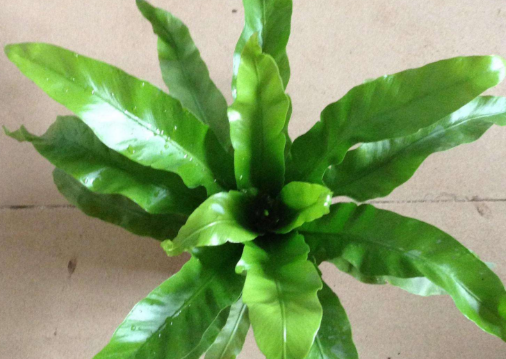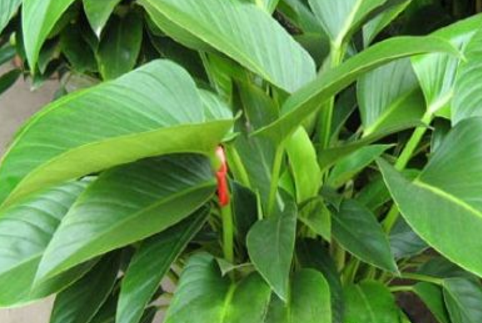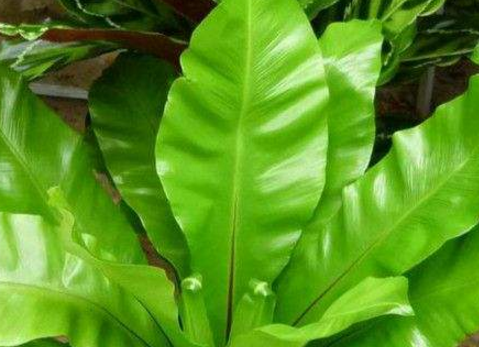Maintenance methods of bird's nest fern
1. Moisture content
Spring and summer is the peak growth period of bird's nest ferns, at this time to water more, but also often spray water to the leaves, so that the leaves neat. And keep the humidity 70%, 80%, do not leave stagnant water, otherwise there will be rotten roots.

two。 Ramet pruning
When the bird's nest fern grows to be very dense, it will produce small branches. at the end of spring, the roots can be cut out and planted separately, and the pot soil should be kept moist when dividing the roots. the newly planted bird's nest ferns can cut off some of the old leaves, which is more conducive to plant growth.
3. Pest prevention
Bird's nest ferns generally do not have pest problems, but when the air is too dry, there will be red spiders, which can be sprayed with special insecticides. Some plants will be harmed by anthrax, and 50% carbendazim 600 times solution is sprayed at the initial stage of the disease to control it.
Well, the above is the treatment of the scorched leaves of the bird's nest fern. I hope the bird's nest fern raised by everyone will be more healthy and beautiful.
The culture method of bird nest fern 1. Temperature
The suitable temperature for the growth of bird's nest fern is 22-27 ℃. It is not resistant to high temperature or cold, and can not be lower than 5 ℃ in winter. Too low temperature can easily cause the leaf margin to turn brown, and even cause plant death by frostbite.
two。 Light
Bird's nest fern is a negative herb, the demand for light is not very large, an appropriate amount of scattered light can maintain its normal growth, to stay away from strong light, and potted plants can be kept in bright indoor light for maintenance.
3. Soil
Bird nest ferns can be made of rotten leaf soil or peat soil, vermiculite and a small amount of river sand, or mixed with fern roots, broken bark, moss or broken brick grains mixed with a small amount of humic soil. A small amount of crushed lime can be added to the basin every spring, which is more conducive to plant growth.
4. Moisture content
Bird's nest ferns grow rapidly in summer, so it is time to water more to keep the air humid. And watering should also pay attention to watering thoroughly, because the leaves will be more and more dense, watering thoroughly can prevent the leaves from drying up and becoming curly.
How to maintain the breeding methods and matters needing attention of bird nest fern
The emerald green leaves of the bird's nest fern spread naturally, like a passionate young man, waving to you. In addition to beauty, it also has medicinal value. So what exactly is the breeding method and points for attention of this bird nest fern all over the body? I believe everyone would like to know, then the following content should not be missed.
Culture methods and matters needing attention of bird nest fern
The bird's nest fern, also known as the mountain flower, is a plant of the fern family Dryopteris, native to eastern Australia, southeastern Asia and Indonesia. The plant is about 0.8-1 m high, with an erect stem, thick and short, the whole scale is broad lanceolate, the main veins are raised on both sides, and the rest of the leaves are scattered naturally. Like other ferns, it produces spores, has no flowering stage, and likes to grow in a hot and humid environment, but it can't help the strong light.
The suitable temperature for growth is between 16 ℃ and 27 ℃, and it is required to grow in wet basin soil and has higher relative air humidity. Due to the high temperature in summer, frequent watering is needed to ensure that the plant has enough water so that the leaves do not dry up and curl. When selecting pot substrate, we can mainly use rotten leaf soil, vermiculite or peat soil, and add a small amount of river sand as culture soil. In the early stage of its growth, it needs to be fertilized every 20 days, and when it matures, it cannot help but apply additional fertilizer.
Edible / medicinal value of bird's nest fern
What many people don't know is that bird's nest ferns have many uses in addition to ornamental value.
It is a little expert at purifying the air. Bird's nest fern is also a necessary green plant in the new house, because it can purify the air and remove the strong smell of formaldehyde, it is also one of the recommended gifts for new homes.
It is a good helper for treating injuries and recuperating diseases. Because it is rich in potassium, iron, calcium, vitamin A, dietary fiber and other substances, it can strengthen muscles and bones, promote blood circulation and remove blood stasis. In addition, it can also be used in the treatment of fractures, headaches, and other diseases.
It is a good dish that tastes bitter and delicious. The tender part of the bird's nest fern can be eaten as long as it is washed and slightly blanched in boiling water, or it can be eaten as a side dish with other ingredients.
After reading the introduction of the bird's nest fern covered with treasures, do you want to raise a bird's nest fern? Although the breeding of bird's nest ferns is not difficult, it should not be taken lightly. You know, it takes time and patience to cultivate a plant well. I hope all plant lovers can get some inspiration from it.
- Prev

Hydroponic method of Golden Diamond
1. Remove the soil from the pot, remove the soil and rotten roots, and rinse clean. However, the root system should be protected so as not to affect the normal growth of the plant. two。 Disinfect the roots of the plant in potassium permanganate, disinfect them for 30 minutes, then wash them again, and wash the pebbles and planting baskets.
- Next

Breeding method of nest fern
When spore propagation comes in spring, disinfect the prepared sowing soil, put it into a pot, then evenly sprinkle mature spores on the pot soil, then immerse the whole pot in water, let the pot soil fully wet, cover the glass pot to keep moisture, and finally put it in a cool place. After about one week, new buds can sprout.
Related
- Fuxing push coffee new agricultural production and marketing class: lack of small-scale processing plants
- Jujube rice field leisure farm deep ploughing Yilan for five years to create a space for organic food and play
- Nongyu Farm-A trial of organic papaya for brave women with advanced technology
- Four points for attention in the prevention and control of diseases and insect pests of edible fungi
- How to add nutrient solution to Edible Fungi
- Is there any good way to control edible fungus mites?
- Open Inoculation Technology of Edible Fungi
- Is there any clever way to use fertilizer for edible fungus in winter?
- What agents are used to kill the pathogens of edible fungi in the mushroom shed?
- Rapid drying of Edible Fungi

